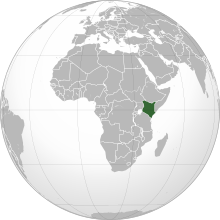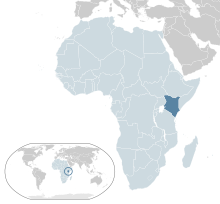
Back Кениа Abkhazian Kenya ACE Кение ADY Kenia Afrikaans Kenia ALS ኬንያ Amharic Kenya AMI Kenya AN Cenia ANG Kenya ANN
Republic of Kenya Jamhuri ya Kenya (Swahili) | |
|---|---|
| Motto: "Harambee" (English: "Let us all pull together") | |
| Anthem: "Ee Mungu Nguvu Yetu" (English: "O God of All Creation") | |
| Capital and largest city | Nairobi 1°16′S 36°48′E / 1.267°S 36.800°E |
| Official languages | |
| National language | Swahili[1] |
| Ethnic groups (2019 census)[2] | |
| Religion |
|
| Demonym(s) | Kenyan |
| Government | Unitary presidential republic |
| William Ruto | |
| Kithure Kindiki | |
| Amason Kingi | |
| Moses Wetangula | |
| Martha Koome | |
| Legislature | Parliament |
| Senate | |
| National Assembly | |
| Independence | |
| 957–1513 | |
• Omani control of Swahili coast | 1698–1887 |
• Dominion | 12 December 1963 |
• Republic | 12 December 1964 |
| 27 August 2010 | |
| Area | |
• Total | 580,367 km2 (224,081 sq mi)[4][5] (48th) |
• Water (%) | 2.3 |
| Population | |
• 2024 estimate | |
• 2019 census | 47,564,296[7] |
• Density | 82/km2 (212.4/sq mi) (124th) |
| GDP (PPP) | 2023 estimate |
• Total | |
• Per capita | |
| GDP (nominal) | 2023 estimate |
• Total | |
• Per capita | |
| Gini (2021) | medium inequality |
| HDI (2022) | medium (146th) |
| Currency | Kenyan shilling (KES) |
| Time zone | UTC+3 (East Africa Time) |
| Date format | dd/mm/yy (AD) |
| Drives on | Left |
| Calling code | +254 |
| ISO 3166 code | KE |
| Internet TLD | .ke |
According to the CIA, estimates for this country explicitly take into account the effects of mortality because of AIDS; this can result in lower life expectancy, higher infant mortality and death rates, lower population and growth rates, and changes in the distribution of population by age and sex, than would otherwise be expected.[11] | |
Kenya, officially the Republic of Kenya (Swahili: Jamhuri ya Kenya), is a country in East Africa. With an estimated population of more than 52.4 million as of mid-2024,[12] Kenya is the 27th-most-populous country in the world[7] and 7th most populous in Africa. Kenya's capital and largest city is Nairobi, while its oldest and second-largest city, is the major port city of Mombasa, situated on Mombasa Island in the Indian Ocean and the surrounding mainland. Mombasa was the capital of the British East Africa Protectorate,[13] which included most of what is now Kenya and southwestern Somalia, from 1889 to 1907. Other important cities include Kisumu and Nakuru. Kenya is bordered by South Sudan to the northwest, Ethiopia to the north, Somalia to the east, Uganda to the west, Tanzania to the south, and the Indian Ocean to the southeast.
Kenya's geography, climate and population vary widely, ranging from cold snow-capped mountaintops (Batian, Nelion and Point Lenana on Mount Kenya) with vast surrounding forests, wildlife and fertile agricultural regions to temperate climates in western and rift valley counties and further on to dry less fertile arid and semi-arid areas and absolute deserts (Chalbi Desert and Nyiri Desert).
Kenya's earliest inhabitants were hunter-gatherers, like the present-day Hadza people.[14][15] According to archaeological dating of associated artifacts and skeletal material, Cushitic speakers first settled in Kenya's lowlands between 3,200 and 1,300 BC, a phase known as the Lowland Savanna Pastoral Neolithic. Nilotic-speaking pastoralists (ancestral to Kenya's Nilotic speakers) began migrating from present-day South Sudan into Kenya around 500 BC.[16] Bantu people settled at the coast and the interior between 250 BC and 500 AD.[17]
European contact began in 1500 AD with the Portuguese Empire, and effective colonisation of Kenya began in the 19th century during the European exploration of Africa. Modern-day Kenya emerged from a protectorate established by the British Empire in 1895 and the subsequent Kenya Colony, which began in 1920. Numerous disputes between the UK and the colony led to the Mau Mau revolution, which began in 1952, and the declaration of independence in 1963. After independence, Kenya remained a member of the Commonwealth of Nations. The current constitution was adopted in 2010 and replaced the 1963 independence constitution.
Kenya is a presidential representative democratic republic, in which elected officials represent the people and the president is the head of state and government.[18] Kenya is a member of the United Nations, the Commonwealth, World Bank, International Monetary Fund, World Trade Organization, COMESA, International Criminal Court, as well as other international organisations. It is also a major non-NATO ally of the United States. With a GNI of 1,840,[19] Kenya is a lower-middle-income economy. Kenya's economy is the second largest in eastern and central Africa, after Ethiopia, with Nairobi serving as a major regional commercial hub.[20] Agriculture is the largest sector; tea and coffee are traditional cash crops, while fresh flowers are a fast-growing export. The service industry is also a major economic driver, particularly tourism. Kenya is a member of the East African Community trade bloc,[21][22] though some international trade organisations categorise it as part of the Greater Horn of Africa.[23] Africa is Kenya's largest export market, followed by the European Union.[24]
- ^ a b Constitution (2009) Art. 7 [National, official and other languages] "(1) The national language of the Republic is Swahili. (2) The official languages of the Republic are Swahili and English. (3) The State shall–-–- (a) promote and protect the diversity of language of the people of Kenya; and (b) promote the development and use of indigenous languages, Kenyan Sign language, Braille and other communication formats and technologies accessible to persons with disabilities."
- ^ a b "2019 Kenya Population and Housing Census Volume IV: Distribution of Population by Socio-Economic Characteristics". Kenya National Bureau of Statistics. Archived from the original on 5 June 2020. Retrieved 24 March 2020.
- ^ "2022 Report on International Religious Freedom: Kenya". United States Department of State. Archived from the original on 31 October 2023. Retrieved 24 December 2023.
- ^ "Demographic Yearbook – Table 3: Population by sex, rate of population increase, surface area and density" (PDF). United Nations Statistics Division. 2012. Archived (PDF) from the original on 26 August 2020. Retrieved 4 September 2017.
- ^ "United Nations Statistics Division – Demographic and Social Statistics". unstats.un.org. Archived from the original on 28 April 2015. Retrieved 4 September 2017.
- ^ "The Kenya National Bureau of Statistics". The Kenya National Bureau of Statistics. Retrieved 23 June 2024.
- ^ a b "2019 Kenya Population and Housing Census Results". Kenya National Bureau of Statistics. 4 November 2019. Archived from the original on 13 November 2019. Retrieved 15 November 2019.
- ^ a b c d "World Economic Outlook Database, October 2023 Edition. (Kenya)". IMF.org. International Monetary Fund. 10 October 2023. Archived from the original on 21 October 2023. Retrieved 13 October 2023.
- ^ "Gini index". World Bank Group. 2019. Archived from the original on 15 June 2023. Retrieved 17 October 2023.
- ^ "Human Development Report 2023/24" (PDF). United Nations Development Programme. 13 March 2024. p. 289. Archived (PDF) from the original on 13 March 2024. Retrieved 13 March 2024.
- ^ Cite error: The named reference
ciawas invoked but never defined (see the help page). - ^ "Kenya National Bureau of Statistics - Kenya's Top Data Site". 23 December 2021. Retrieved 11 January 2025.
- ^ "Mombasa | History, Map, Location, Population, & Facts | Britannica". www.britannica.com. 10 January 2025. Retrieved 11 January 2025.
- ^ "African Hunter-Gatherers: Survival, History and Politics of Identity" (PDF). repository.kulib.kyoto-u.ac.jp. Archived (PDF) from the original on 4 November 2018. Retrieved 18 October 2021.
- ^ "The East African Bushmen". researchgate.net. Archived from the original on 9 January 2022. Retrieved 18 October 2021.
- ^ Cite error: The named reference
EhretCHSwas invoked but never defined (see the help page). - ^ "Wonders Of The African World". pbs. Archived from the original on 19 October 2019. Retrieved 18 October 2021.
- ^ "Victorian Electronic Democracy – Final Report – Table of ContentsVictorian Electronic Democracy – Final Report – Glossary". 13 December 2007. Archived from the original on 13 December 2007. Retrieved 29 January 2019.
- ^ "GNI per capita, Atlas method (current US$) – Kenya". worldbank.org. World Bank. Archived from the original on 15 April 2023. Retrieved 3 May 2022.
- ^ Oluwole, Victor (24 July 2023). "African giants: The 10 largest economies on the continent". Business Insider Africa. Archived from the original on 3 January 2024. Retrieved 26 November 2023.
- ^ "East African Community" (PDF). eala.org. Archived (PDF) from the original on 24 December 2023. Retrieved 19 December 2023.
- ^ "East African Federation". eac.int. Archived from the original on 15 December 2023. Retrieved 19 December 2023.
- ^ Maxwell, Daniel, and Ben Watkins. "Humanitarian information systems and emergencies in the Greater Horn of Africa: logical components and logical linkages." Disasters 27.1 (2003): 72–90.
- ^ Mwangi S. Kimenyi; Francis M. Mwega; Njuguna S. Ndung'u (May 2016). "The African Lions: Kenya country case study" (PDF). The Brookings Institution. Archived (PDF) from the original on 27 May 2016. Retrieved 23 May 2016.



